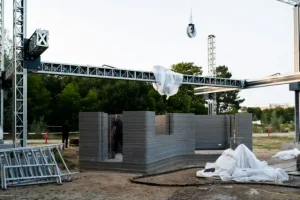3DCP sustainability is a major factor why 3DCP (three-dimensional concrete printing) has taken off recently. It is recognized as a newer, superior form of construction when compared to traditional concrete construction.
3DCP Sustainability: Ranking the Benefits
Waste Reduction
One of the most significant benefits of 3D printing is its ability to reduce waste. Traditional manufacturing processes often result in a significant amount of waste, as materials are cut, drilled, and shaped to create the desired product. With 3D home printing, however, we can create products with minimal waste, as the printer only uses the exact amount of material needed to create the object. This benefit is particularly important in industries such as aerospace and automotive, construction, where the production of large, complex parts can result in significant waste. By using 3D printing to create these parts, manufacturers can reduce waste and save money on materials.
Energy Efficiency
Another 3DCP sustainability benefit, is its potential to reduce the energy required for manufacturing. Traditional manufacturing processes often require large amounts of energy to power machinery and transport materials. With 3D printing, however, we can create products on-site, reducing the need for transportation and minimizing the energy required to manufacture products.
This benefit is particularly important in industries such as construction, where the transportation of materials can be a significant source of carbon emissions. By using 3D printing to create building components on-site, manufacturers can reduce the carbon footprint of construction projects.
Customization
Another benefit of 3D printing is its potential for customization. With traditional manufacturing processes, products are often mass-produced, resulting in a one-size-fits-all approach. With 3D printing, however, we can create products that are tailored to the specific needs of the customer, reducing the amount of waste and increasing customer satisfaction.
This benefit is particularly important in industries such as healthcare, where customized medical devices can improve patient outcomes. By using 3D printing to create these devices, manufacturers can improve the quality of care while reducing waste. Similarly in the construction industry, the same thought can be put together when building houses.
Local Production
Another benefit of 3D printing is its potential to enable local production. Traditional manufacturing processes often require products to be produced in centralized locations and then transported to their final destination. With 3D printing, however, we can create products on-site, reducing the need for transportation and enabling local production. This benefit is particularly important in industries such as agriculture, and construction where the production of farm equipment and building supplies. can be a significant source of carbon emissions. By using 3D printing to create these products on-site, farmers can reduce the carbon footprint of their operations.
Material Efficiency
Finally, 3D printing has the potential to improve material efficiency. Traditional manufacturing processes often require large amounts of material to be cut, drilled, and shaped to create the desired product. With 3D printing, however, we can create products with minimal waste, as the printer only uses the exact amount of material needed to create the object. This is incredibly unique in the construction process.
This benefit is particularly important in industries such as fashion, where the production of clothing can be a significant source of waste. By using 3D printing to create clothing, designers can reduce waste and improve the sustainability of their products.

Conclusion
In conclusion, 3DCP has the potential to revolutionize the way we manufacture products, making it more efficient, cost-effective, and sustainable. By reducing waste, minimizing the carbon footprint of manufacturing, enabling customization, enabling local production, and improving material efficiency, 3D printing can help us create a more sustainable future.
Based on the potential impact of these benefits, I would rank waste reduction as the most significant benefit of 3D printing for sustainability. By reducing waste, we can save money on materials, reduce the carbon footprint of manufacturing, and improve the sustainability of our products.
Energy efficiency would be the second most significant benefit, as it has the potential to reduce the carbon footprint of manufacturing and transportation. Customization would be the third most significant benefit, as it can improve the quality of care in healthcare and reduce waste in other industries.
Local production and material efficiency would be the fourth and fifth most significant benefits, respectively, as they have the potential to reduce the carbon footprint of agriculture and fashion.
Overall, 3D printing has the potential to transform the way we manufacture products, making it more sustainable and environmentally friendly. I’m excited to see how this technology will continue to evolve and contribute to a better world. Printerra can be part of the solution for housing sustainability and reducing costs.



